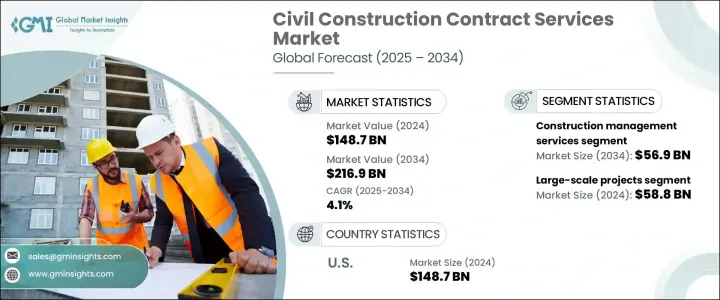
|
시장보고서
상품코드
1766179
토목 건설 계약 서비스 시장 기회, 성장 촉진요인, 산업 동향 분석, 예측(2025-2034년)Civil Construction Contract Services Market Opportunity, Growth Drivers, Industry Trend Analysis, and Forecast 2025 - 2034 |
||||||
세계의 토목 건설 계약 서비스 시장은 2024년에는 1,487억 달러로 평가되었고, 2034년에는 2,169억 달러에 이르며, CAGR은 4.1%를 나타낼 것으로 전망됩니다.
이러한 성장은 주로 북미, 아시아, 유럽의 각국 정부가 주도하는 대규모 인프라 구상에 의해 초래됩니다. 아시아태평양에서는 인도의 '국가 인프라 파이프라인'과 일본의 '국토 강인화 계획' 등의 정책 틀이 EPC 기업과 계약 서비스 제공업체가 필수적인 실행자가 되는 다년 수요 파이프라인을 구축하고 있습니다.

이러한 프로그램은 수십억의 자금을 할당할 뿐만 아니라, 보다 신속한 프로젝트 승인을 위한 제도적 메커니즘을 설정하고, 토목 계약자에 대한 수요를 더욱 강화하고 있습니다. 이러한 메가 도시 프로젝트는 단계적 구현, 엄격한 품질 준수 및 실시간 프로젝트 관리를 요구합니다.
| 시장 범위 | |
|---|---|
| 시작 연도 | 2024년 |
| 예측 연도 | 2025-2034년 |
| 시작 금액 | 1,487억 달러 |
| 예측 금액 | 2,169억 달러 |
| CAGR | 4.1% |
건설관리서비스 부문은 2024년에 413억 달러를 창출했고 2034년에는 569억 달러에 이를 것으로 예측되고 있습니다. 사용자가 참여하는 환경,(EPC 및 설계 시공과 같은) 통합된 전달 모델, 스케줄 및 예산, 품질 기준의 엄격한 준수가 요구되고 있는 것에 기인하고 있습니다. 제공업체는 소유자, 설계자, 하도급업자, 공급업체, 규제 당국을 연결하는 핵심 역할을 하며 공공 및 민간 부문 프로젝트 모두에서 원활한 실행을 보장합니다.
대규모 프로젝트 분야는 자본가치가 높고 복잡하며 국가개발과제와의 전략적 관련성이 높기 때문에 2024년 588억 달러를 창출했고 39.6%의 점유율을 차지했습니다. 이러한 공사는 종합적인 계획, 다단계 시공, 엄격한 규제·안전·지속가능성 기준의 준수가 요구됩니다.
미국의 토목 건설 계약 서비스 시장은 2024년 1,487억 달러로 평가되었고 2025년부터 2034년까지 연평균 복합 성장률(CAGR) 4.1%를 나타낼 것으로 예측됩니다. 이는 광대한 인프라 네트워크, 연방 정부의 지속적인 투자, 계약자, 프로젝트 소유자, 규제기관의 성숙한 생태계에 의한 것입니다. 이 때문에 일관된 프로젝트의 파이프라인이 형성되어 그 대부분은 설계 시공이나 EPC 등의 서비스 주도형 모델에 의해 실시됩니다.
토목 건설 계약 서비스 시장 주요 기업은 CPB Contractors, Vinci SA, Larsen & Toubro(L& T), Fluor Corporation, Bouygues Construction, Hyundai Engineering & Construction, Gamuda Berhad, ACS Group, Shanghai Construction Group Co.Ltd. Pallonji Group, China Communications Construction Company(CCCC), Skanska AB, Ferrovial입니다. 토목 건설 계약 서비스 시장에서 각 회사가 존재감을 높이기 위해 채용하고 있는 주요 전략에는 설계·계획에서 건설·유지보수에 이르기까지 프로젝트의 라이프사이클 전체를 망라하는 서비스의 확충이 포함됩니다. 또한 기업은 프로젝트의 효율성, 정확성, 안전성을 향상시키기 위해 빌딩 정보 모델링(BIM), 드론, 인공지능 등의 선진 기술에 투자하고 있습니다.
목차
제1장 조사 방법과 범위
제2장 주요 요약
제3장 업계 인사이트
- 생태계 분석
- 공급자의 상황
- 이익률
- 각 단계에서의 부가가치
- 밸류체인에 영향을 주는 요인
- 업계에 미치는 영향요인
- 성장 촉진요인
- 업계의 잠재적 위험 및 과제
- 기회
- 성장 가능성 분석
- 향후 시장 동향
- 기술과 혁신의 상황
- 현재의 기술 동향
- 신흥기술
- 규제 상황
- 표준 및 규정 준수 요건
- 지역 규제 틀
- 인증기준
- Porter's Five Forces 분석
- PESTEL 분석
제4장 경쟁 구도
- 서론
- 기업의 시장 점유율 분석
- 지역별
- 북미
- 유럽
- 아시아태평양
- 지역별
- 기업 매트릭스 분석
- 주요 시장 기업의 경쟁 분석
- 경쟁 포지셔닝 매트릭스
- 주요 발전
- 합병과 인수
- 파트너십 및 협업
- 확장 계획
제5장 시장 추정·예측 : 서비스 유형별(2021-2034년)
- 주요 동향
- 건설 관리 서비스
- 설계 및 엔지니어링 서비스
- 프로젝트 계획 및 개발
- 품질관리 및 안전관리
- 장비 및 자재 공급
- 현장 관리 서비스
제6장 시장 추정·예측 : 계약 유형별(2021-2034년)
- 주요 동향
- 일시불 계약
- 단가 계약
- 비용 플러스 계약
- 설계-건설 계약
- 시간 및 자재 계약
제7장 시장 추정·예측 : 프로젝트 유형별(2021-2034년)
- 주요 동향
- 주거용 건물
- 상업용 건물
- 산업 시설
- 인프라 프로젝트
- 도로 및 고속도로
- 교량 및 터널
- 철도
- 공항
- 항구 및 해양 구조물
- 기타(에너지 및 유틸리티 프로젝트 등)
제8장 시장 추정·예측 : 프로젝트 규모별(2021-2034년)
- 주요 동향
- 소규모 프로젝트
- 중규모 프로젝트
- 대규모 프로젝트
- 초대형 프로젝트
제9장 시장 추정·예측 : 최종 용도별(2021-2034년)
- 주요 동향
- 정부 및 공공 부문
- 민간 개발자
- 업계 단체
- 부동산 회사
- 인프라 개발 당국
제10장 시장 추정·예측 : 지역별(2021-2034년)
- 주요 동향
- 북미
- 미국
- 캐나다
- 유럽
- 독일
- 영국
- 프랑스
- 이탈리아
- 스페인
- 네덜란드
- 아시아태평양
- 중국
- 인도
- 일본
- 한국
- 호주
- 라틴아메리카
- 브라질
- 멕시코
- 아르헨티나
- 중동 및 아프리카
- 아랍에미리트(UAE)
- 사우디아라비아
- 남아프리카
제11장 기업 프로파일
- ACS Group
- Bechtel Corporation
- Bouygues Construction
- China Communications Construction Company(CCCC)
- CPB Contractors
- Ferrovial
- Fluor Corporation
- Gamuda Berhad
- Hyundai Engineering & Construction
- Laing O'Rourke
- Larsen &Toubro(L&T)
- Shapoorji Pallonji Group
- Shanghai Construction Group Co. Ltd.
- Skanska AB
- Vinci SA
The Global Civil Construction Contract Services Market was valued at USD 148.7 billion in 2024 and is estimated to grow at a CAGR of 4.1% to reach USD 216.9 billion by 2034. This growth is primarily driven by large-scale infrastructure initiatives spearheaded by governments across North America, Asia, and Europe. These national infrastructure programs aim to stimulate economic recovery, support urbanization, and transition toward resilient infrastructure systems. In the Asia-Pacific region, policy frameworks such as India's National Infrastructure Pipeline and Japan's National Resilience Program have created multi-year demand pipelines where EPC firms and contract service providers are essential executors.

These programs not only allocate billions in funding but also set up institutional mechanisms for faster project approval, further intensifying demand for civil contractors. The cumulative effect of such policy-backed investments is a structural increase in long-term contracts, particularly for tier-1 and tier-2 service providers who can scale operations and meet compliance criteria. Such mega-urban projects require phased execution, strict quality adherence, and real-time project management-competencies that are typically externalized to specialized contract service firms. As cities modernize, contractors are expected not just to build but to operate under service-based models, marking a strategic shift in how value is created in the sector.
| Market Scope | |
|---|---|
| Start Year | 2024 |
| Forecast Year | 2025-2034 |
| Start Value | $148.7 Billion |
| Forecast Value | $216.9 Billion |
| CAGR | 4.1% |
The construction management services segment generated USD 41.3 billion in 2024 and is anticipated to reach USD 56.9 billion by 2034. Construction Management Services (CMS) dominate the civil construction contract services market due to their strategic role in overseeing, coordinating, and optimizing every phase of the construction lifecycle. Their dominance stems from the growing complexity of infrastructure projects, which increasingly involve multi-stakeholder environments, integrated delivery models (like EPC and Design-Build), and strict compliance with timelines, budgets, and quality standards. CMS providers act as the nerve center-bridging owners, designers, subcontractors, suppliers, and regulators-ensuring seamless execution in both public and private sector projects.
The large-scale projects segment generated USD 58.8 billion in 2024 and held 39.6% share, due to their high capital value, complexity, and strategic relevance to national development agendas. These projects such as cross-country expressways, mass transit systems, industrial corridors, and international airports command significantly larger budgets and longer timelines, resulting in substantial contract volumes for service providers. They require comprehensive planning, multi-phase execution, and adherence to strict regulatory, safety, and sustainability standards. As a result, civil construction services such as project management, engineering design, cost estimation, and risk mitigation become indispensable throughout the lifecycle of these projects, driving consistent demand across multiple service categories.
U.S. Civil Construction Contract Services Market was valued at USD 148.7 billion in 2024 and is anticipated to register a CAGR of 4.1% between 2025 and 2034, due to its expansive infrastructure network, sustained federal investment, and mature ecosystem of contractors, project owners, and regulatory institutions. The country maintains one of the world's largest inventories of public infrastructure spanning highways, bridges, airports, railways, and water systems which require ongoing modernization, capacity expansion, and resilience upgrades. This creates a consistent pipeline of projects, many of which are executed through service-driven models like Design-Build and EPC. The scale and frequency of such developments generate high-value, multi-year contract opportunities, reinforcing the U.S. as a central hub for construction service activities.
Major players in the Civil Construction Contract Services Market include CPB Contractors, Vinci SA, Larsen & Toubro (L&T), Fluor Corporation, Bouygues Construction, Hyundai Engineering & Construction, Gamuda Berhad, ACS Group, Shanghai Construction Group Co. Ltd., Laing O'Rourke, Bechtel Corporation, Shapoorji Pallonji Group, China Communications Construction Company (CCCC), Skanska AB, and Ferrovial. Key strategies adopted by companies in the civil construction contract services market to strengthen their presence include expanding their service offerings to encompass the entire project lifecycle, from design and planning to construction and maintenance. This integrated approach allows firms to provide comprehensive solutions, enhancing their competitiveness. Additionally, companies are investing in advanced technologies such as Building Information Modeling (BIM), drones, and artificial intelligence to improve project efficiency, accuracy, and safety. Strategic partnerships and joint ventures are also common, enabling firms to leverage local expertise and access new markets.
Table of Contents
Chapter 1 Methodology & Scope
- 1.1 Market scope and definition
- 1.2 Research design
- 1.2.1 Research approach
- 1.2.2 Data collection methods
- 1.3 Data mining sources
- 1.3.1 Global
- 1.3.2 Regional/Country
- 1.4 Base estimates and calculations
- 1.4.1 Base year calculation
- 1.4.2 Key trends for market estimation
- 1.5 Primary research and validation
- 1.5.1 Primary sources
- 1.6 Forecast model
- 1.7 Research assumptions and limitations
Chapter 2 Executive Summary
- 2.1 Industry 3600 synopsis
- 2.2 Key market trends
- 2.2.1 Regional
- 2.2.2 Service
- 2.2.3 End use
- 2.3 CXO perspectives: Strategic imperatives
- 2.3.1 Key decision points for industry executives
- 2.3.2 Critical success factors for market players
- 2.4 Future Outlook and Strategic Recommendations
Chapter 3 Industry Insights
- 3.1 Industry ecosystem analysis
- 3.1.1 Supplier Landscape
- 3.1.2 Profit Margin
- 3.1.3 Value addition at each stage
- 3.1.4 Factor affecting the value chain
- 3.2 Industry Impact forces
- 3.2.1 Growth drivers
- 3.2.2 Industry pitfalls & challenges
- 3.2.3 Opportunities
- 3.3 Growth potential analysis
- 3.4 Future market trends
- 3.5 Technology and Innovation landscape
- 3.5.1 Current technological trends
- 3.5.2 Emerging technologies
- 3.6 Regulatory landscape
- 3.6.1 Standards and compliance requirements
- 3.6.2 Regional regulatory frameworks
- 3.6.3 Certification standards
- 3.7 Porter's analysis
- 3.8 PESTEL analysis
Chapter 4 Competitive Landscape, 2024
- 4.1 Introduction
- 4.2 Company market share analysis
- 4.2.1 By region
- 4.2.1.1 North America
- 4.2.1.2 Europe
- 4.2.1.3 Asia Pacific
- 4.2.1 By region
- 4.3 Company matrix analysis
- 4.4 Competitive analysis of major market players
- 4.5 Competitive positioning matrix
- 4.6 Key developments
- 4.6.1 Mergers & acquisitions
- 4.6.2 Partnerships & collaborations
- 4.6.3 Expansion Plans
Chapter 5 Market Estimates & Forecast, By Service Type, 2021 - 2034 (USD Billion)
- 5.1 Key trends
- 5.2 Construction management services
- 5.3 Design and engineering services
- 5.4 Project planning and development
- 5.5 Quality control and safety management
- 5.6 Equipment and material supply
- 5.7 Site management services
Chapter 6 Market Estimates & Forecast, By Contract Type, 2021 - 2034, (USD Billion)
- 6.1 Key trends
- 6.2 Lump sum contract
- 6.3 Unit price contract
- 6.4 Cost plus contract
- 6.5 Design-build contract
- 6.6 Time and material contract
Chapter 7 Market Estimates & Forecast, By Project Type, 2021 - 2034, (USD Billion)
- 7.1 Key trends
- 7.2 Residential buildings
- 7.3 Commercial buildings
- 7.4 Industrial facilities
- 7.5 Infrastructure projects
- 7.5.1 Roads and highways
- 7.5.2 Bridges and tunnels
- 7.5.3 Railways
- 7.5.4 Airports
- 7.5.5 Ports and marine structures
- 7.6 Others (Energy and Utility Projects, etc.)
Chapter 8 Market Estimates & Forecast, By Project Size, 2021 - 2034, (USD Billion)
- 8.1 Key trends
- 8.2 Small-scale projects
- 8.3 Medium-scale projects
- 8.4 Large-scale projects
- 8.5 Mega projects
Chapter 9 Market Estimates & Forecast, By End Use, 2021 - 2034, (USD Billion)
- 9.1 Key trends
- 9.2 Government and public sector
- 9.3 Private developers
- 9.4 Industrial organizations
- 9.5 Real estate companies
- 9.6 Infrastructure development authorities
Chapter 10 Market Estimates & Forecast, By Region, 2021 - 2034, (USD Billion)
- 10.1 Key trends
- 10.2 North America
- 10.2.1 U.S.
- 10.2.2 Canada
- 10.3 Europe
- 10.3.1 Germany
- 10.3.2 U.K.
- 10.3.3 France
- 10.3.4 Italy
- 10.3.5 Spain
- 10.3.6 Netherlands
- 10.4 Asia Pacific
- 10.4.1 China
- 10.4.2 India
- 10.4.3 Japan
- 10.4.4 South Korea
- 10.4.5 Australia
- 10.5 Latin America
- 10.5.1 Brazil
- 10.5.2 Mexico
- 10.5.3 Argentina
- 10.6 MEA
- 10.6.1 UAE
- 10.6.2 Saudi Arabia
- 10.6.3 South Africa
Chapter 11 Company Profiles (Business Overview, Financial Data, Product Landscape, Strategic Outlook, SWOT Analysis)
- 11.1 ACS Group
- 11.2 Bechtel Corporation
- 11.3 Bouygues Construction
- 11.4 China Communications Construction Company (CCCC)
- 11.5 CPB Contractors
- 11.6 Ferrovial
- 11.7 Fluor Corporation
- 11.8 Gamuda Berhad
- 11.9 Hyundai Engineering & Construction
- 11.10 Laing O’Rourke
- 11.11 Larsen & Toubro (L&T)
- 11.12 Shapoorji Pallonji Group
- 11.13 Shanghai Construction Group Co. Ltd.
- 11.14 Skanska AB
- 11.15 Vinci SA



















